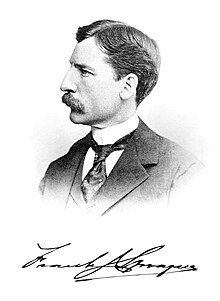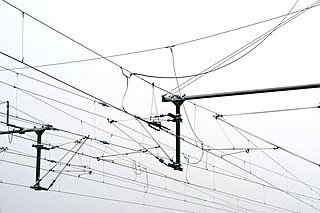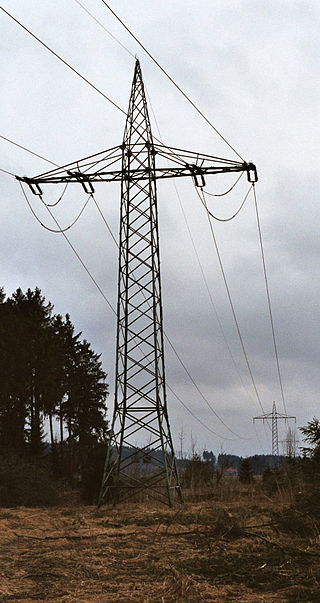This article needs additional citations for verification .(May 2007) |
Railway electric traction describes the various types of locomotive and multiple units that are used on electrification systems around the world.
This article needs additional citations for verification .(May 2007) |
Railway electric traction describes the various types of locomotive and multiple units that are used on electrification systems around the world.

Railway electrification as a means of traction emerged at the end of the nineteenth century, although experiments in electric rail have been traced back to the mid-nineteenth century. [1] Thomas Davenport, in Brandon, Vermont, erected a circular model railroad on which ran battery-powered locomotives (or locomotives running on battery-powered rails) in 1834. [1] Robert Davidson, of Aberdeen, Scotland, created an electric locomotive in 1839 and ran it on the Edinburgh-Glasgow railway at 4 miles per hour. [1] The earliest electric locomotives tended to be battery-powered. [1] In 1880, Thomas Edison built a small electrical railway, using a dynamo as the motor and the rails as the current-carrying medium. The electric current flowed through the metal rim of otherwise wooden wheels, being picked up via contact brushes. [1]
Electrical traction offered several benefits over the then predominant steam traction, particularly in respect of its quick acceleration (ideal for urban (metro) and suburban (commuter) services) and power (ideal for heavy freight trains through mountainous/hilly sections). A plethora of systems emerged in the first twenty years of the twentieth century.
Direct current (DC) traction units use current drawn from a third rail, fourth rail, ground-level power supply or an overhead line. AC voltage is converted into DC voltage by using a rectifier.
Alternating current (AC) traction units involve an inverter and produce variable traction output based on the frequency of the AC current. They are equipped in most modern rolling stock for lower maintenance cost and easier scalability relative to DC units.
This section needs additional citations for verification .(December 2015) |
Because of the variety of railway electrification systems, which can vary even within a country, trains often have to pass from one system to another. One way to accomplish this is by changing locomotives at the switching stations. These stations have overhead wires that can be switched from one voltage to another and so the train arrives with one locomotive and then departs with another. The switching stations have very sophisticated components and they are very expensive.
A less expensive switching station may have different electrification systems at both exits with no switchable wires. Instead the voltage on the wires changes across a small gap in them near the middle of the station. Electric locomotives coast into the station with their pantographs down and halt under a wire of the wrong voltage. A diesel shunter can then return the locomotive to the right side of the station. Both approaches are inconvenient and time-consuming, taking about ten minutes.
Another way is to use multi-system motive power that can operate under several different voltages and current types. In Europe, two-, three- and four-system locomotives for cross-frontier freight traffic are becoming a common sight (1.5 kV DC, 3 kV DC, 15 kV 16.7 Hz AC, 25 kV 50 Hz AC). [2] Locomotives and multiple units so equipped can, depending on line configuration and operation rules, pass from one electrification system to another without a stop, coasting for a short distance for the changeover, past the dead section between the different voltages.
Eurostar trains through the Channel Tunnel are multisystem; a significant part of the route near London was on southern England's 750 V DC third rail system, the route into Brussels is 3 kV DC overhead, while the rest of the route is 25 kV 50 Hz overhead. The need for these trains to use third rail into London Waterloo station ended upon completion of High Speed 1 line in 2007. Southern England uses some overhead/third rail dual-system locomotives, such as the class 92 for Channel Tunnel, and multiple units, e.g. the Class 319 on Thameslink services, to allow through running between 750 V DC third rail south of London and 25 kV AC overhead north and east of London.
Electro-diesel locomotives, which can operate as an electric locomotive on electrified lines but have an on-board diesel engine for non-electrified sections or sidings, have been used in several countries; examples are the British Class 73 from the 1960s and the last mile concept from around 2011, where an electric freight locomotive can work sidings under Diesel power (TRAX dual mode).
A few battery electric railcars and locomotives were used in the twentieth century, but generally the use of battery power was not practical except in underground mining systems. See Accumulator car and Battery locomotive.
Many high-speed rail systems use electric trains, such as the Shinkansen and the TGV.

A locomotive is a rail transport vehicle that provides the motive power for a train. If a locomotive is capable of carrying a payload, it is usually rather referred to as a multiple unit, motor coach, railcar or power car; the use of these self-propelled vehicles is increasingly common for passenger trains, but rare for freight trains.

An overhead line or overhead wire is an electrical cable that is used to transmit electrical energy to electric locomotives, electric multiple units, trolleybuses or trams. The generic term used by the International Union of Railways for the technology is overhead line. It is known variously as overhead catenary, overhead contact line (OCL), overhead contact system (OCS), overhead equipment (OHE), overhead line equipment, overhead lines (OHL), overhead wiring (OHW), traction wire, and trolley wire.

A third rail, also known as a live rail, electric rail or conductor rail, is a method of providing electric power to a railway locomotive or train, through a semi-continuous rigid conductor placed alongside or between the rails of a railway track. It is used typically in a mass transit or rapid transit system, which has alignments in its own corridors, fully or almost fully segregated from the outside environment. Third-rail systems are usually supplied from direct current electricity.

An electric locomotive is a locomotive powered by electricity from overhead lines, a third rail or on-board energy storage such as a battery or a supercapacitor. Locomotives with on-board fuelled prime movers, such as diesel engines or gas turbines, are classed as diesel–electric or gas turbine–electric and not as electric locomotives, because the electric generator/motor combination serves only as a power transmission system.

Railway electrification is the use of electric power for the propulsion of rail transport. Electric railways use either electric locomotives, electric multiple units or both. Electricity is typically generated in large and relatively efficient generating stations, transmitted to the railway network and distributed to the trains. Some electric railways have their own dedicated generating stations and transmission lines, but most purchase power from an electric utility. The railway usually provides its own distribution lines, switches, and transformers.

A traction motor is an electric motor used for propulsion of a vehicle, such as locomotives, electric or hydrogen vehicles, or electric multiple unit trains.

A traction network or traction power network is an electricity grid for the supply of electrified rail networks. The installation of a separate traction network generally is done only if the railway in question uses alternating current (AC) with a frequency lower than that of the national grid, such as in Germany, Austria and Switzerland.

Railway electrification systems using alternating current (AC) at 25 kilovolts (kV) are used worldwide, especially for high-speed rail. It is usually supplied at the standard utility frequency, which simplifies traction substations. The development of 25 kV AC electrification is closely connected with that of successfully using utility frequency.

Railway electrification using alternating current (AC) at 15 kilovolts (kV) and 16.7 hertz (Hz) are used on transport railways in Germany, Austria, Switzerland, Sweden, and Norway. The high voltage enables high power transmission with the lower frequency reducing the losses of the traction motors that were available at the beginning of the 20th century. Globally, railway electrification in late 20th century tends to use 25 kV, 50 Hz AC systems which has become the preferred standard for new railway electrifications. Nevertheless, local extensions of the existing 15 kV network is commonplace. In particular, the Gotthard Base Tunnel uses 15 kV, 16.7 Hz electrification.

In rail transport, head-end power (HEP), also known as electric train supply (ETS), is the electrical power distribution system on a passenger train. The power source, usually a locomotive at the front or 'head' of a train, provides the electricity used for heating, lighting, electrical and other 'hotel' needs. The maritime equivalent is hotel electric power. A successful attempt by the London, Brighton and South Coast Railway in October 1881 to light the passenger cars on the London to Brighton route heralded the beginning of using electricity to light trains in the world.

An electro-diesel locomotive is a type of locomotive that can be powered either from an electricity supply or by using the onboard diesel engine. For the most part, these locomotives are built to serve regional, niche markets with a very specific purpose.

Alstom Traxx is a modular product platform of mainline diesel-electric and electric locomotives. It was produced originally by Bombardier Transportation and later Alstom, and was built in both freight and passenger variants. The first version was a dual-voltage AC locomotive built for German railways from the year 2000. Later types included DC versions, as well as quadruple-voltage machines, able to operate on all four electrification schemes commonly used in Europe. The family was expanded in 2006 to include diesel-powered versions. Elements common to all variants include steel bodyshells, two bogies with two powered axles each, three-phase asynchronous induction motors, cooling exhausts on the roof edges, and wheel disc brakes.
Railroad electrification in the United States began at the turn of the 20th century and comprised many different systems in many different geographical areas, few of which were connected. Despite this situation, these systems shared a small number of common reasons for electrification.

A battery electric multiple unit (BEMU), battery electric railcar or accumulator railcar is an electrically driven multiple unit or railcar whose energy can be supplied from rechargeable batteries driving the traction motors.

Amtrak’s 60 Hz traction power system operates along the Northeast Corridor between New Haven, Connecticut, and Boston, Massachusetts. This system was built by Amtrak in the late 1990s and supplies locomotives with power from an overhead catenary system at 25 kV alternating current with at 60 Hz, the standard frequency in North America. The system is also known as the Northend Electrification, in contrast to Amtrak's 25 Hz traction power system that runs between New York City and Washington, D.C., which is known as the Southend Electrification system.

A multi-system locomotive, also known as a multi-system electric locomotive, multi-system electric multiple unit, or multi-system train, is an electric locomotive which can operate using more than one railway electrification system. Multi-system trains provide continuous journeys over routes which are electrified using more than one system.

The New York, New Haven and Hartford Railroad pioneered electrification of main line railroads using high-voltage, alternating current, single-phase overhead catenary. It electrified its mainline between Stamford, Connecticut, and Woodlawn, New York, in 1907 and extended the electrification to New Haven, Connecticut, in 1914. While single-phase AC railroad electrification has become commonplace, the New Haven's system was unprecedented at the time of construction. The significance of this electrification was recognized in 1982 by its designation as a Historic Mechanical Engineering Landmark by the American Society of Mechanical Engineers (ASME).

The Transnet Freight Rail Class 20E of 2013 is a South African electric locomotive.

An electro-diesel multiple unit (EDMU) or bi-mode multiple unit (BMU) is a form of a multiple unit train that can be powered either by electric power picked up from the overhead lines or third rail or by using an onboard diesel engine, driving an electric generator, which produces alternating current (AC) or direct current (DC) electric power.
Traxx MS (multi-system) for operation on both AC (15 and 25 kV) and DC (1·5 and 3 kV) networks